Siete qui:
- Home
- The MODO Museum
- Art and artists
- Collections of the Papal Palaces â Ground floor â Fresco Gallery
Collections of the Papal Palaces â Ground floor â Fresco Gallery
The frescoes on the ground floor in the collections of the Papal Palaces are of considerable interest. They include fourteenth- and fifteenth-century fragments from the "grande officina" or "great workshop" of Orvieto, documenting on the one hand the apprenticeship and at times autonomous development (Andrea Di Giovanni) of many artists who worked in the Cathedral workshop under Ugolino di Prete Ilario, and on the other the influence and diffusion in the latter decades of the fourteenth century of the pictorial idiom of Orvieto in various areas of central Italy. After restoration, begun in the mid 1980s by the Laboratorio Dipinti Murali of the Istituto Centrale per il Restauro, they are now available to the public for the first time as an organic excursus, chronologically and stylistically selected.
Area of Orvieto
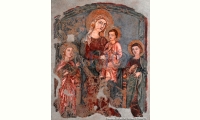 Madonna and Child with Saint Catherine of Alexandria and Saint John the Evangelist
Madonna and Child with Saint Catherine of Alexandria and Saint John the Evangelist
Early 14th century
Detached fresco; 122 x 100 cm.
Restoration: ICR, 1986-2007
After restoration, this fresco has taken on new life and can be assigned to the early fourteenth century, to which the style and the technique of the execution of the halos bear witness. At the time various artists were working in Orvieto. They probably belonged to the same workshop and their work is generically indicated as being by the "Maestro della Madonna di San Brizio". This fresco falls into that category and can be attributed to the same person who painted a crowned saint between two patrons in the second chapel on the left in the Cathedral of Orvieto. Note how the hands of Mary and the Christ Child touch. Catherine can be identified by her attribute the wheel.
Area of Todi
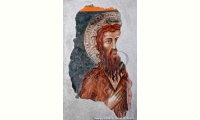 Saint John the Baptist
Saint John the Baptist
15th century
Detached fresco; 75 x 48 cm.
Restoration: ICR, 1986-2007
This fragment depicts the precursor of Christ, in his camel skin and with his right hand pointing upwards.
The modeling of the head is quite powerful and his reddish hair and beard are described in detail.
The saint's halo is particularly rich with two concentric bands of impressed motifs, the outer one with a row of beading and the inner one with five-petal rosettes. This type of halo is rather rare in Orvieto, and the artist may therefore have come from the area of Todi where it is a rather frequent motif.
Area of Umbria-Siena
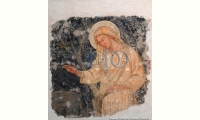 Madonna of the Olive Tree
Madonna of the Olive Tree
Early fifteenth century
Detached fresco; 98 x 84 cm.
Provenance: Orvieto, church of San Martino ai Servi
Restoration: ICR, 1986-2007
While the figure in this fragment had been generically identified as a young saint it is actually a "Madonna of the Olive Tree" who appeared to a child in Assisi in August of 1399. As he was accompanying his father to work in the fields "...the child suddenly started...a figure all dressed in white appeared in an olive tree", telling him not to be frightened and inviting him to take her message to the people ... it was the Madonna..."
To be noted the stole, the vestment that marks recipients of Holy Orders, crossed over her breast as worn by officiating priests.
This subject was widespread thanks to the Confraternity of the Bianchi who went to Rome for the Jubilee of 1400. The fresco was therefore probably painted in that year by a good painter, perhaps from Siena.
Area of Orvieto
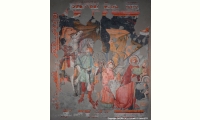 Adoration of the Kings
Adoration of the Kings
Last quarter 14th century
Detached fresco; 280 x 240 cm.
Restoration: ICR, 1986-2007
Despite the fact that so much of this fresco is missing, it is clear that it was painted by a particularly gifted artist. Comparison with a similar subject painted by Andrea di Giovanni (n. 7) confirms this impression.
There is a certain grandiosity to the scene and the figures are particularly elegant, providing us with an idea of fashions of the time.
It is difficult to say just who the artist of this small masterpiece, previously identified as Pietro di Puccio, was. So far none of the known artists, from Ugolino to Petruccioli, Andrea di Giovanni or Pietro himself, seem to fit the bill. So for now we prefer leaving the artist as anonymous in hopes that some fortunate documentary discover will help us solve the problem.
Ugolino di Prete Ilario
(active in Orvieto 1356 - 1384)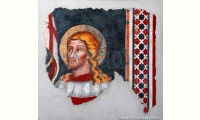 Crowned Female Martyr Saint (not shown here) and Knight Saint holding a banner
Crowned Female Martyr Saint (not shown here) and Knight Saint holding a banner
Detached fresco; 57 x (56 + 56) cm
Restoration: ICR, 1986-2007
The two fragments were part of a single composition as shown by the style and frame. They have been attributed to a local follower of the Sienese painter Lippo Vanni. Actually they are important evidence of the activity of Ugolino di Prete Ilario.
This is clear from a comparison with the documented works of the Orvieto master, the frescoes in the chapel of the Corporal (1357-64) and in the tribune of the Cathedral (130-1380). In particular the relationship with the cycle of the Life of Mary is particularly convincing and would indicate a date somewhere in the eighth decade of the fourteenth century.
Andrea di Giovanni
(active in Orvieto 1378 – ca. 1420)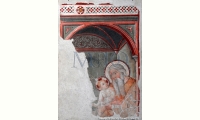 Presentation of Jesus at the Temple
Presentation of Jesus at the Temple
Detached fresco; 108 x 74 cm.
Provenance: Orvieto, oratory of Santa Maria del Carmine.
Restoration: ICR, 1986-2007
A large part of the scene, set in a building with ribbed cross vaulting and with a niche in the background, is missing on the left.
To be set in relation to the Nativity and Adoration of the Magi (see n. 7).
Andrea di Giovanni
(active in Orvieto 1378 – ca. 1420)
 Nativity and Adoration of the Magi
Nativity and Adoration of the Magi
Early 15th century
Detached fresco; 190 x (166+166) cm.
Provenance: Orvieto, oratory of Santa Maria del Carmine
Restoration: ICR, 1986-2007
Together with the Presentation at the Temple, these two scenes must have been part of a cycle dedicated to the Infancy of Christ. Analysis of the style confirms their attribution to Andrea di Giovanni, Orvietan painter, who was trained with Ugolino di Prete Ilario in the frescoes in the tribune of the Cathedral where he is documented between 1378 and 1380. The three frescoes are related to various paintings by the master, the lunette of the Cathedral, the Virgin and Child over the portal of San Domenico, the Belverde cycle near Cetona and the "Standard of the Innocent Saints" in San Ludovico. They can be dated to the beginning of the fifteenth century.
Previously the two panels had been mounted together with a depiction of the Trinity, which however differed stylistically (see n. 8).
Area of Orvieto
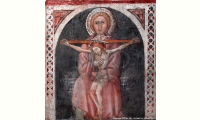 Trinity
Trinity
Early 15th century
Detached fresco; 60 x 60 cm.
Provenance: Orvieto, oratory of Santa Maria del Carmine.
Of rather modest quality, this work with God the Father, the dove or Holy Spirit, and Christ, had been coupled with the two frescoes of the Nativity and the Adoration of the Magi (n. 7), attributed to Andrea di Giovanni.
Careful examination however revealed that the small painting did not belong there and that it was not in the style of Andrea. It is therefore to be referred to one of many late fourteenth/early fifteenth-century painters listed in the Archives as collaborators without mention of their works.
Area of Orvieto
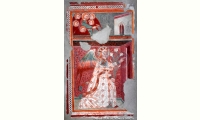 Annunciation
Annunciation
Early 15th century
Detached fresco; 195 x (116 + 116) cm.
Provenance: Orvieto, church of Santo Spirito al Tamburino.
On the whole the references to Ugolino di Prete Ilario and Pietro di Puccio noted by Garzelli seem to accurate.
To be noted in particular the fine chest next to Mary's bed (not shown in this illustration) similar to those that appear more than once in the Marian cycle in the tribune of the Cathedral, while the general layout is close to Pietro di Puccio's Annunciation in the church of the Carmine, dated 1394. Also to be noted is the Gothic two-light window in the right upper corner.
The exuberant decoration of the scene however would indicate an early fifteenth-century date.
Pietro di Nicola Baroni
(active in Orvieto 1447 - 1484) Ecce Homo with Saint Pietro Parenzo and Saint Faustino
Ecce Homo with Saint Pietro Parenzo and Saint Faustino
1468
Detached fresco; 105 x 200 cm.
Inscription: IN ISTA CASSA R[E]/CONDITA SUNT CORP[O]/RA SANCTORUM MARTIRUM FAUST/[INI] ET PETRY PARENS[I]/ QUORUM MERITIS INTER/CESSIONIBUS DEUS [CIVITATEM]/ HANC [ELUIT] [...]
Provenance: Orvieto, cathedral, chapel of San Brizio
Restoration: Cooperativa CBC, 1996
This fresco, originally in the small chapel of the Holy Bodies, to the right in the Chapel of San Brizio, was painted in 1468 by Pietro di Nicola Baroni. It was then hidden by a wall on which Luca Signorelli painted the Pietà and Saints Faustino and Pietro Parenzo.
Archive documents had made mention of this fresco and it was recovered in the most recent restorations of the Chapel.
Area of Orvieto
 Hermit Saint
Hermit Saint
Early 15th century
Detached fresco; 103 x 47 cm.
Restoration: ICR, 1986-2007
The hermit saint in this small fresco has been identified as Saint Macarius of Egypt, also known as Macarius the Great, who died in 391. He spent years in the desert and founded the Monastery of Saint Macarius the Great.
It can be assigned to an Orvieto artist active in the early fifteenth century working in parallel with the workshop of Pietro di Nicola Baroni.
Circle of Nicola Baroni
 Madonna and Child
Madonna and Child
Second half 15th century
Detached fresco; 99 x 58 cm.
Restoration: ICR, 1986-2007
This fairly well preserved fresco depicts the traditional group of the Virgin Mary and Child. The frontal blocky pose with the doll-like Christ Child would seem to indicate that the artist had in mind a much older image, perhaps a medieval icon.
Stylistically, the fresco is typical of the local production, subsequent to Fra Angelico's work in the Cathedral. Even though close to the works of Pietro di Nicola's corpus, it differs in the greater attention to the modeling and the softer colors.
Area of Orvieto
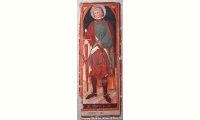 Saint Julian the Hospitaller
Saint Julian the Hospitaller
Second quarter 15th century
Detached fresco; 173 x 64 cm.
Provenance: Orvieto, via Carducci, building formerly belonging to Viti
Restoration: ICR, 1986-2007
The style of this well-preserved fresco indicates that it dates to the second quarter of the fifteenth century, a transitional moment for painting in Orvieto, ranging from the arrival in Orvieto of Gentile da Fabriano (1425) to before Fra Angelico's presence around twenty years later. The figure of the knight saint, of whom there is also a fresco in the church of Sant Andrea in Orvieto, is still late Gothic, in the dress, refined elegance, and in the setting, consisting of no more than a bit of marble floor striped red and green. It was probably painted by an artist from the workshop of Pietro di Nicola still under the influence of Gentile da Fabriano.



